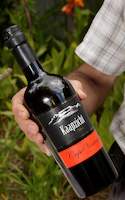After Danie Steytler father’s death in 1985, the budding winemaker and his younger brother George started focussing on developing the vineyards and making and bottling more of their own wine.

They started replacing the swathes of chenin with classic reds such as cabernet sauvignon, merlot and shiraz. Although there were some existing pinotage vines on the farm, Danie felt the variety showed potential in the area and planted more.
Eventually about 10 varieties were established, with attention to the farm's varying microclimates: reds on the warmer west-to-northwest-facing slopes; sauvignon blanc and chardonnay high up on the cooler south-facing slopes.
Kaapzicht's first reds, an unwooded and wooded pinotage, were made in 1990. They heralded the arrival of a red wine brand to watch. With Danie and his brother George at home in the vineyards and cellar and Yngvild on the road and in the air, touting their wines to local and international buyers, the inevitable organic growth of the werf[estate] is recorded in the photo album.
In 1989, the rambling homestead, secluded among the hills a couple of kilometres up an uneven, partly bricked dirt road, opened to the public for tastings and sales in an old outbuilding. As Danie steadily added to his range of bottled Wines - cabernets, merlots, red blends - more second-hand stainless steel fermenting tanks were bought.
'But we couldn’t fit these massive things into the onginat production cellar, so Danie and the farm workers built a base for each and lined them up against an outside wall,' says Yngvild. Danie tells of wines guarded against night-time raids by thirsty wanderers, homespun alarm systems as deterrents, and makeshift mending of damaged tanks.
Finally they simply extended the cellar to encompass the tanks. It entailed expanding across the dirt road running between the cellar and Danie and Yngvild's house. There are pictures of the original tasting room - literally a 'room', now the 'office' - while another, bigger outbuilding was renovated to welcome wine lovers.
As exports grew thanks to Yngvild's tireless trips abroad to visit trade shows, agents and buyers, a big wine store was built opposite the cellar. A photo shows bare ground between the buildings that was eventually paved. 'We did all this work ourselves: Danie, George and our farm labourers.'
Needing extra help in the vineyards during the 1993 harvest, Danie advertised in the newspapers (a French tradition) for grape pickers. Expecting to provide work for a few locals, he ended up receiving responses from jobless people across all nationalities, including backpackers from overseas.
'They just came and set up tents, creating what was then hailed by some newspapers as the first multi-racial harvesting team in South Africa. We had to provide ablution facilities and Yngvild was making three meals a day for everyone. It was great fun, but quite daunting.'
'They ate chicken for breakfast, lunch and supper,' jokes his wife. Because, while being cook, nurse and mother to her young charges (as well as her own children), the energetic Yngvild was raising chickens and running an 'abattoir' on the farm. [A qualified nursing sister born and bred in northern Germany, Yngvild had come to southern Africa to do development work, which is when this vintner met his wife.]
Businesslike Yngvild continues her chicken story: 'What started as a small hatchery supplying friends and community kitchens to improve our finances, turned into a fully fledged business producing over SO 000 chickens a year. It also gave the women on the farm an additional income, especially during the vineyard off-season.'
But after 12 years the municipality shut her down. 'Not that I minded too much because, in 1997, Danie asked me officially to handle the whole export side of the business and the work of simultaneously running a household, the chicken business and the wine exports was getting too much.'
Some 80 per cent of their production now goes overseas, under their own export labels (Kaapzicht, Cape View, Friesland), or to clients. Yngvild does up to five or six trips a year. 'Danie prefers to stay at home. He really loves his vineyards.'
By the turn of the millennium, the wines from those lovingly nurtured vineyards were being noticed. Besides the rated Kaapzicht Cabernet Sauvignon, the Pinotage had become a regular in the annual listing of the ABSA Top 10 Pinotage Awards, soon joined by Shiraz, Merlot and Sauvignon Blanc. Just for good measure, the versatile Danie's Hanepoot Jerepigo fortified sweet wine had been winning Ventas gold medals too. At the end of 1999, he was inducted into the Guild.
 Korrel toast recipe by Danie Steytler served with butternut soup and paired with Kaapzicht Chenin Blanc....
Korrel toast recipe by Danie Steytler served with butternut soup and paired with Kaapzicht Chenin Blanc.... Traditional lamb shank potjie recipe by Danie Steytler paired with Steytler Pentagon wine....
Traditional lamb shank potjie recipe by Danie Steytler paired with Steytler Pentagon wine....